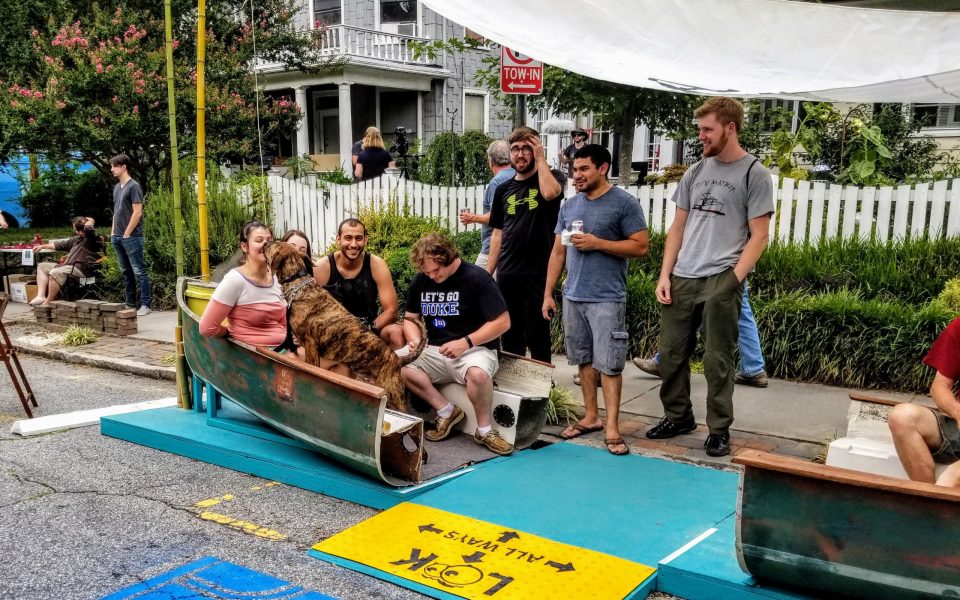For several years, members of the College Hill Neighborhood Association hoped to mitigate the unrelenting dangers of brazen collegiate drivers and unbothered trucks-drivers but if you’ve taken a recent stroll through the historic district, a sawed-in-half sailboat parked where Carr and Mendenhall streets meet may have come as a surprise. And it isn’t awaiting a tune-up from an adoring owner –– it’s an interactive art installment with built-in seating and shade-providing sails, designed to help slow down speeding traffic.
“College Hill’s one of the weirdest districts in all of Greensboro,” James Keith, the neighborhood association president, said. “We have an historic district that is heavily impacted by two institutions of education — and that’s great — but [there are] a lot of people passing through day-to-day: Parking here, going to class and leaving. Everybody’s welcome here but slow the hell down.”
Keith said he and other community members want to reclaim neighborhood streets with a combination of physical interventions and quirky artwork they hope will slow motorists down while asserting a unique neighborhood identity.
In late June, the city contracted with Team Better Block, a group of urban-planning experts, to provide tech services and big-picture ideas for tackling traffic volume and compliance issues in collaboration with College Hill residents and city employees. Cofounder Andrew Howard and his colleague Jonathan Braddick met with the community in mid-July when long-fermenting frustration gave way to dialogue and locally generated ideas.
The humble forest-green sailboat was one of them. The $100 craigslist.com purchase is parked right outside Keith’s front lawn.
“Every morning, I wake up and the kids are sitting on my step [waiting for the school bus] and now they’re in the boat,” Keith said. “How cool is that? People are hanging out where it would’ve just been a car; now it’s a sense of place.”
Less-charming modifications like roadblocks that create chicanes are forged from recycled truck tires and are mobile, allowing for experimentation whereas old-school solutions like speed bumps are to implement and put significant wear on vehicles.
“It’s kind of like Legos for the street,” Howard said. “Some odd ingredients come together when traffic [concerns are] being met with culture and community. [The process is] a mixture of homegrown ideas with the latest technology.”
Beth Langlois, a 23-year resident of College Hill, drew sketches for pavement art throughout the Mendenhall area, but not before testing paint on two parking spaces in front of her home. Her experimentation inspired other residents to decorate spaces on Aug. 1, National Night Out, when the implementation team unveiled the changes in a celebration with food, music and street painting. Some of the 100 or so residents who came out that night filled Langlois’ enormous sunflower sketch with canary yellow and peach petals and a center mimicking a ladybug’s shell on a circular, purple background. According to Keith, Greensboro hasn’t passed an ordinance allowing street art — unlike High Point — so volunteers used tempera paint on pavement. Though faded, the sunflower is still visible at the intersection of Rankin and Mendenhall.[pullquote]Follow the College Hill Neighborhood Plan’s progress on collegehillneighborhoodplan.wordpress.com and learn more about Team Better Block on teambetterblock.com.[/pullquote]
“We had neighbors come over who’ve lived here forever but we never knew [and] we saw so many [city planning department] employees like Jeff Sovich sitting in our street painting,” Keith said. “They were here, they were active, and that meant so much to us.”
In homage to the neighborhood’s history, Langlois painted College Hill’s logo inside the pergola at Mendenhall and Walker, and stenciled blue jeans in two crosswalks referencing the city’s denim-manufacturing companies Wrangler and Cone, which have been in Greensboro for more than a century.
All pavement art and physical interventions are temporary, though. In September, Howard and Braddick will return with recommendations for the rest of the neighborhood using Mendenhall as a case study. In the meantime, planners are taking note of where and how often vehicles hit the experimental roadblocks and compliance with speed limits and street signage, but are also evaluating changes in community perception through a survey. Howard said they want to know if residents are talking with their neighbors more often, whether there are more front-lawn parties and whether the art is influencing residents’ sense of pride in their neighborhood.
Langlois and Keith are both optimistic about street art’s ability to bring neighbors together and signal College Hill’s self-determined identity to the rest of the city.
“[The art] puts a little smile on people’s faces and makes the neighborhood recognizable,” Langlois said. “They think, Oh, people care around here, so maybe they’ll start caring about [our neighborhood], too.”
Join the First Amendment Society, a membership that goes directly to funding TCB‘s newsroom.
We believe that reporting can save the world.
The TCB First Amendment Society recognizes the vital role of a free, unfettered press with a bundling of local experiences designed to build community, and unique engagements with our newsroom that will help you understand, and shape, local journalism’s critical role in uplifting the people in our cities.
All revenue goes directly into the newsroom as reporters’ salaries and freelance commissions.





Please! Let’s keep the Historic District historic and not some millennial art project. We should’t be using special tax district money for things that don’t elevate the intrinsic value of the community. And “weird” is not an improvement.